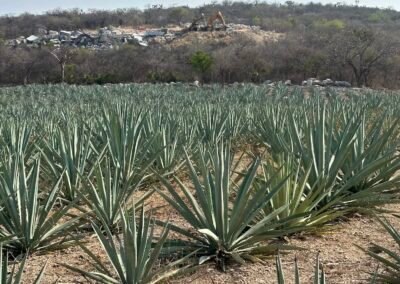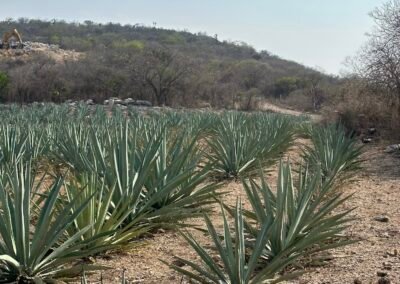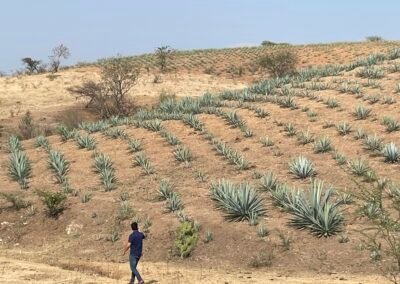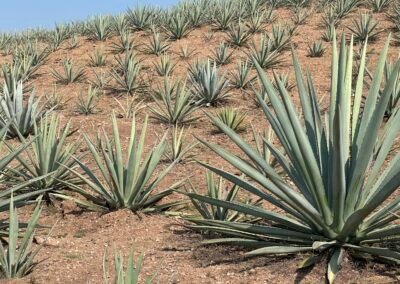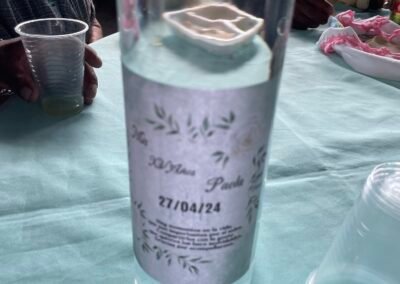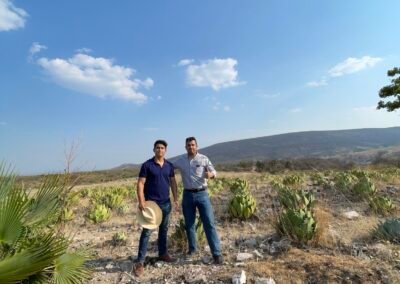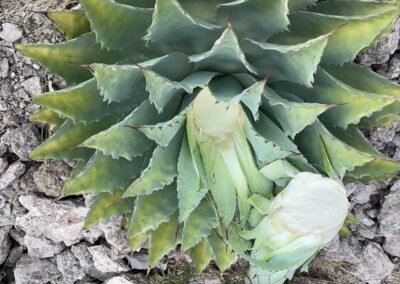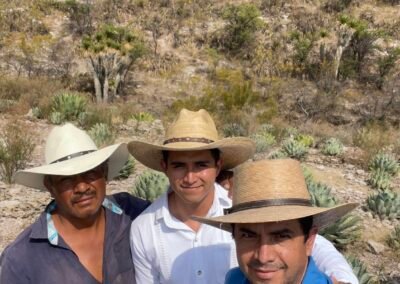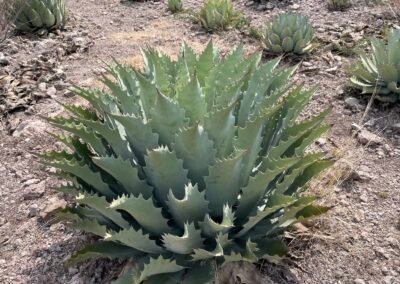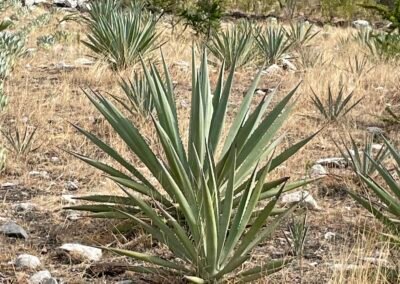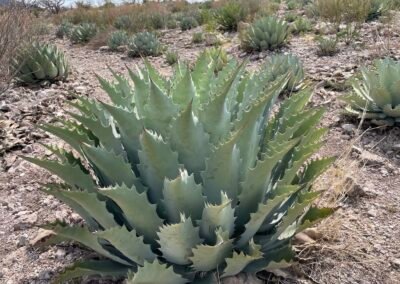MEZCAL POBLANO
Mezcal is a distilled alcoholic beverage made from the agave plant in Mexico. It’s known for its smoky flavor, which comes from roasting the agave hearts in earthen pits. Unlike tequila, which can only be made from blue agave in specific regions, mezcal can be made from various agave species and in different parts of Mexico, though Oaxaca and Puebla are the most well-known region for its production. Here’s a more detailed:
Production:
- Agave: Mezcal is made from the agave plant, with different species used depending on the region and producer.
- Cooking: The agave hearts (piñas) are roasted in earthen pits lined with volcanic rock, wood, and charcoal, giving mezcal its characteristic smoky flavor.
- Grinding: After roasting, the piñas are crushed to extract the juice.
- Fermentation: The juice is then fermented with water.
- Distillation: Finally, the fermented liquid is distilled, often in clay or copper pots.
Traditionally, mezcal is handcrafted by small-scale producers. A village can contain dozens of production houses, called fábricas or palenques, each using methods that have been passed down from generation to generation, some using the same techniques practiced 200 years ago. This is an important difference with tequila which is nowadays mostly produced industrially.
The process begins by harvesting the plants, which can weigh 40 kg (88 pounds) each, and extracting the piña, or heart, by cutting off the plant’s leaves and roots. The piñas are then cooked for about three days, often in pit ovens, which are earthen mounds over pits of hot rocks. This underground roasting gives mezcal its intense and distinctive smoky flavor. They are then crushed and mashed (traditionally by a stone wheel turned by a horse) and then left to ferment in large vats or barrels with water added.
The mash is allowed to ferment, the resulting liquid collected and distilled in either clay or copper pots which will further modify the flavor of the final product. The distilled product is then bottled and sold. Unaged mezcal is referred to as joven, or young. Some of the distilled product is left to age in barrels between one month and four years, but some can be aged for as long as 12 years. Mezcal can reach an alcohol content of 55%. Like tequila, mezcal is distilled twice. The first distillation is known as ordinario, and comes out at around 75 proof (37.5% alcohol by volume). The liquid must then be distilled a second time to raise the alcohol percentage.
Flavor:
- Smoky: The roasting process imparts a distinct smoky flavor to mezcal.
- Sweet and Earthy: Depending on the agave type and production methods, mezcal can also have sweet and earthy notes.
Serving and Consumption:
- Neat:
Mezcal is often enjoyed neat, allowing for a full appreciation of its flavors. - With Orange and Salt:
- It’s also commonly served with a slice of orange and a pinch of sal de gusano (worm salt).
- Cocktails:
Mezcal is increasingly popular in cocktails, adding a smoky complexity to drinks.
Cultural Significance:
- Ancestral Tradition:
- Mezcal production is deeply rooted in Mexican culture and history, with many families passing down their recipes and techniques through generations.
- Symbol of Mexico:
- Internationally, mezcal has been recognized as an Appellation of Origin (AO, DO) since 1994. There is also a Geographical Indication, originally limited to the states of Oaxaca, Guerrero, Durango, San Luis Potosí, Puebla and Zacatecas. Similar products are made in Jalisco, Guanajuato, Michoacán, and Tamaulipas, but these have not been included in the mezcal DO.
- Traditionally the word «mezcal» has been used generally in Mexico for all agave spirits and it continues to be used for many agave spirits whether these spirits have been legally certified as «mezcal» or not. Within Mexico, mezcal is regulated under Norma Oficial Mexicana (NOM) regulations, originally NOM-070-SCFI-1994 (in 1994), by the industry body Consejo Mexicano Regulador de la Calidad del Mezcal A.C. (COMERCAM, the Mexican Regulatory Council for Mezcal Quality). This regulation became law in 2003, and certification began in 2005.
Modern mezcal is divided into three categories certified by the Norma Oficial Mexicana:
Mezcal – For mezcal produced with high-efficiency modern production methods and modern equipment like autoclaves, diffusers, and stainless steel or copper column stills. It is sometimes derisively referred to as «industrial mezcal» (mezcal industrial).
Artisanal mezcal (mezcal artesanal) – For mezcal produced using artisanal stills. Autoclaves, diffusers, and column stills are prohibited. The agave hearts must be cooked in pit hearths or clay/brick ovens. Milling must be done with mallets, stone mills, or mechanical mills. The juice must be fermented in animal skins or pits or tanks made with stone, clay, or wood. The most common types of stills used are the copper or stainless steel alembic-type stills (used by the vast majority), the modified refrescador alembic-type stills with a refrescadera (a cylinder of continuously flowing cold water surrounding the still head), and the Filipino-type stills. Mezcal produced in this way are distilled once, twice, or thrice, depending on the regional tradition, but the most common number of distillations is twice. The vast majority of certified mezcal belong to this category.
Ancestral mezcal (mezcal ancestral) – For mezcal produced completely by traditional methods. Stainless steel and modern equipment are prohibited. This requires the agave hearts to be pit-cooked and crushed by mallets or stone mills. The juice must be fermented in animal skins or pits or tanks made with stone, clay, or wood. It must only be distilled using Filipino-type stills made of clay or wood.
The «Wine Paris 2025» event was held in Paris, France, where #MezcalPoblano brands participated to showcase their products internationally. The event took place in February 2025 and was attended by more than 40,000 visitors from 137 countries.
Among the brands representing Puebla at this important event were:
- Arráncame la Vida
- 60 Fierros
- Mexcalito de mi Corazón
- Tesoro de Atlapulco
- Joya de los Cerritos
- Pink Agave
- Mi Ofrenda
- Orgullo Poblano
- La Atlixquense
This marks the tenth anniversary of the #MezcalPoblano Designation of Origin, further consolidating its position in the world of spirits.
Key Differences from Tequila:
Agave:
Tequila is exclusively made from blue agave in specific regions of Mexico, while mezcal can be made from various agave species in different parts of the country.
Flavor:
While both are distilled from agave, tequila generally has a smoother, less smoky flavor than mezcal.
Production:
While both involve cooking, grinding, fermentation, and distillation, the methods and types of equipment used can differ, leading to variations in flavor profiles.
For more information visit: www.mezcalpoblano.mx

